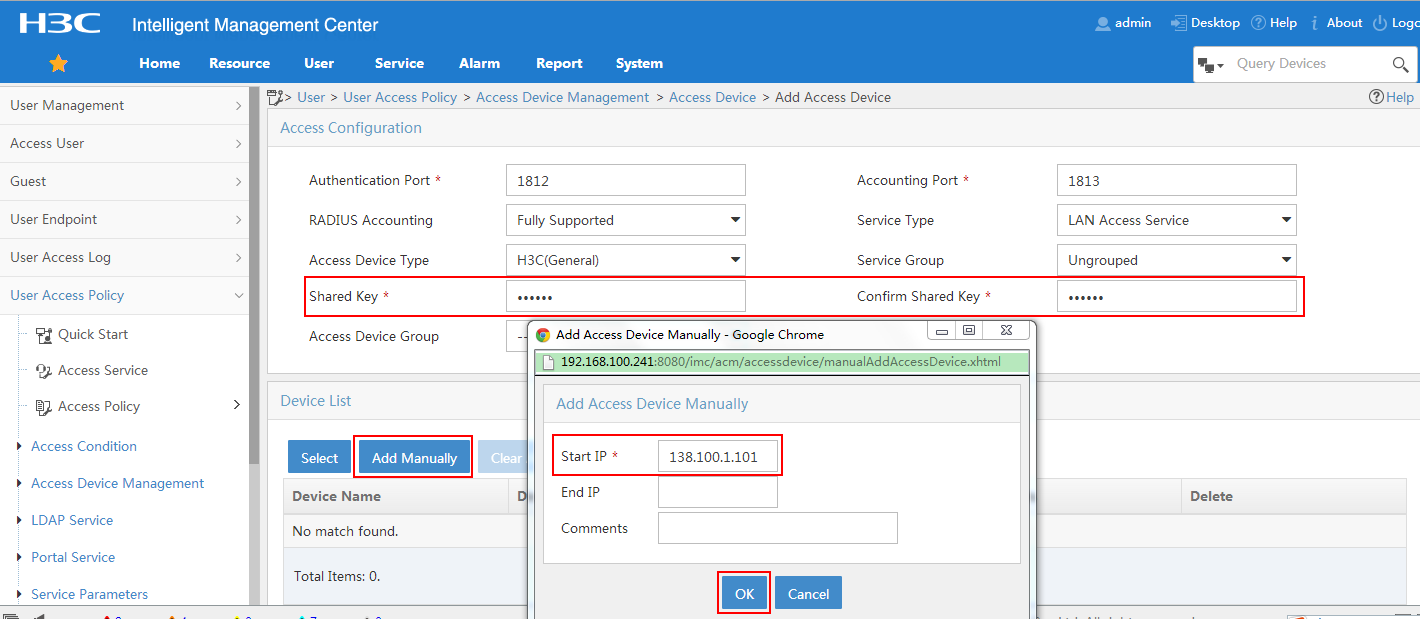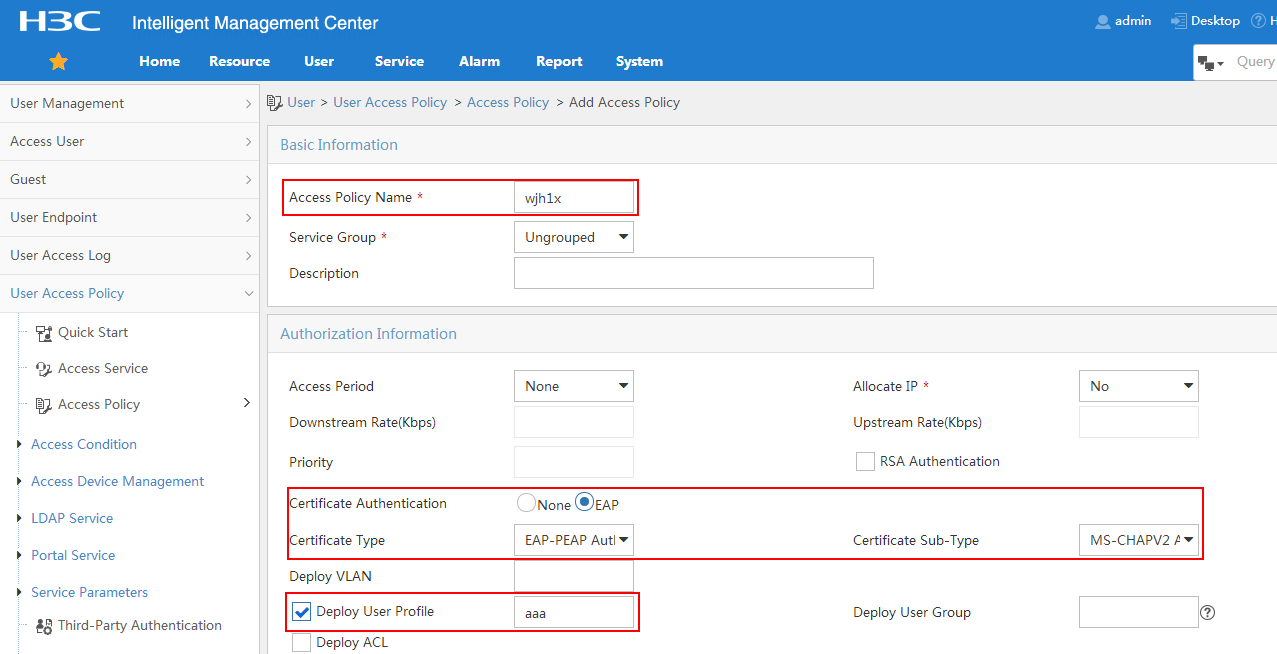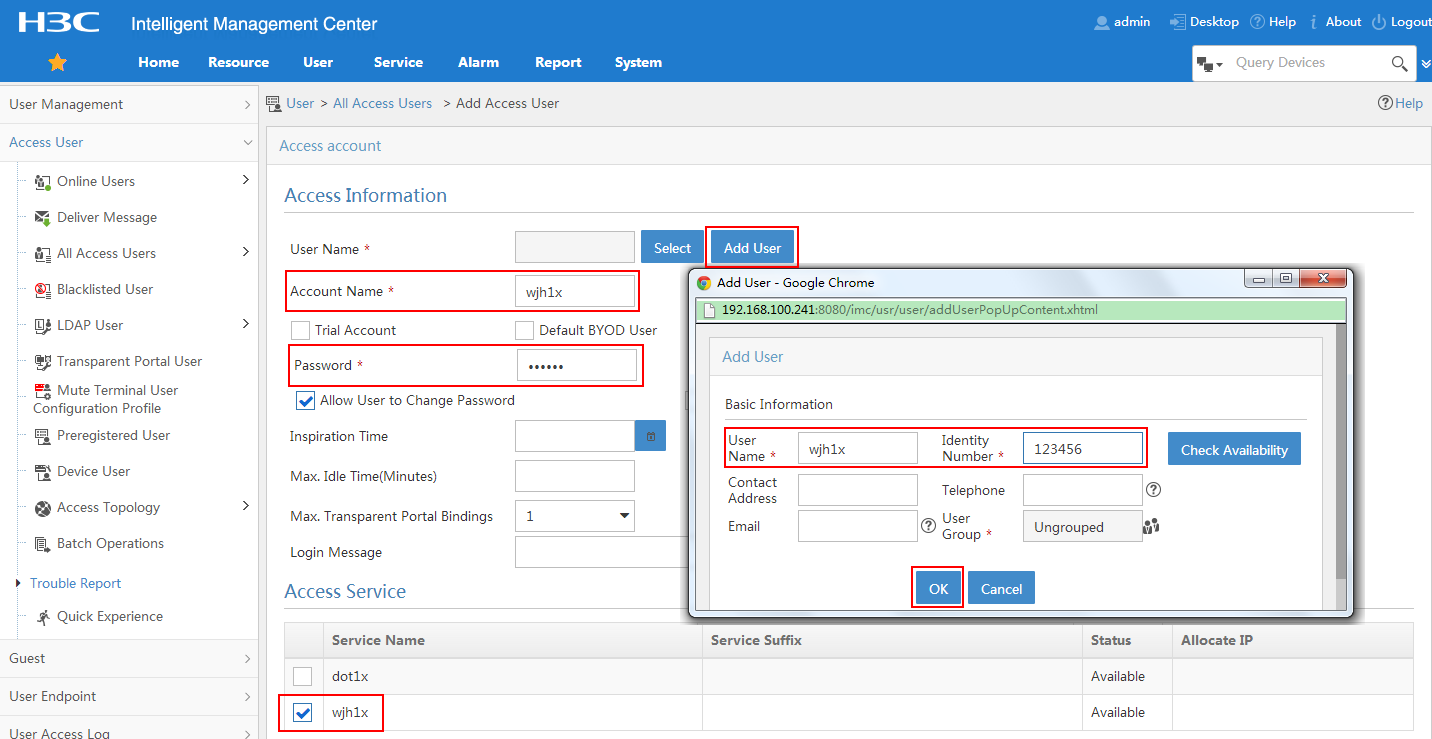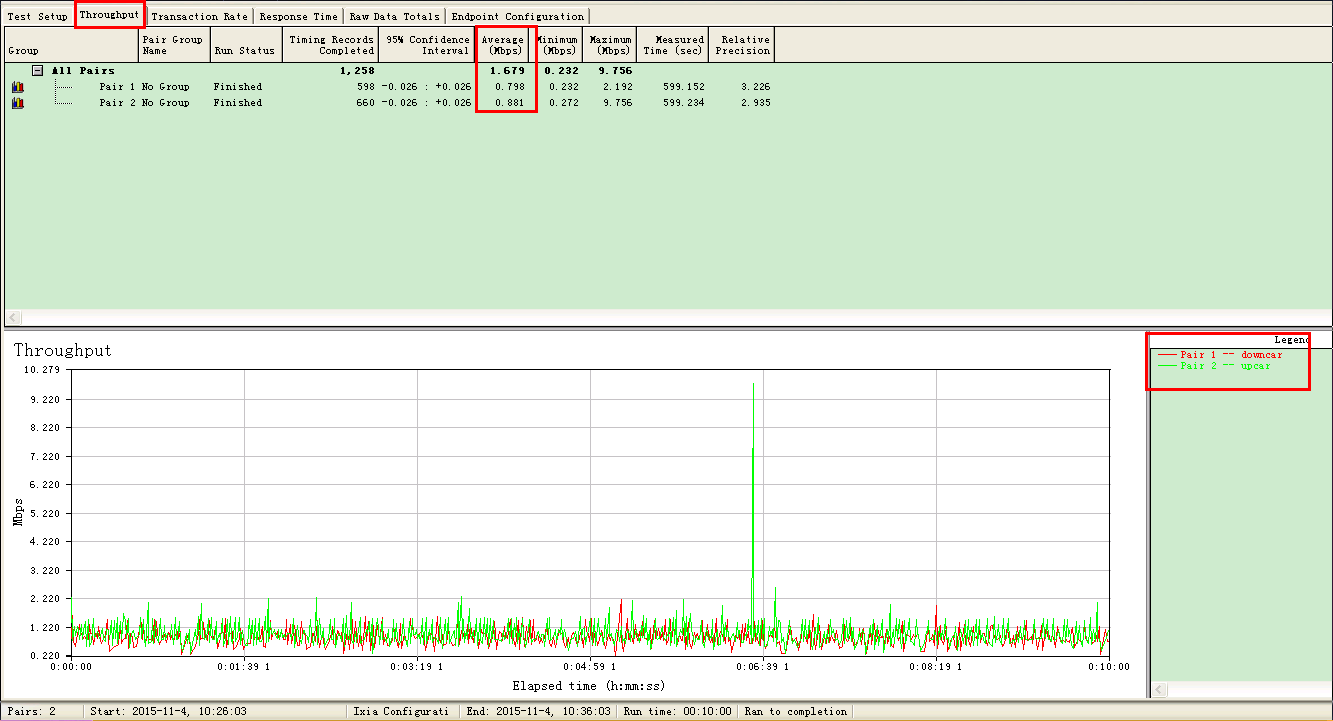- Table of Contents
-
- 05-Comware 9 CLI-based configuration examples (AC+fit AP deployment)
- 01-HTTPS Login Configuration Examples
- 02-SSH Configuration Examples
- 03-License Management Configuration Examples
- 04-AP Association with the AC at Layer 2 Configuration Examples
- 05-AP Association with the AC at Layer 2 (IPv6) Configuration Examples
- 06-Auto AP Configuration Examples
- 07-AP Association with the AC at Layer 3 Configuration Examples
- 08-AP Association with the AC at Layer 3 (IPv6) Configuration Examples
- 09-WEP Encryption Configuration Examples
- 10-PSK Encryption Configuration Examples
- 11-WPA3-SAE PSK Encryption Configuration Examples
- 12-WLAN Access (IPv6) Configuration Examples
- 13-Policy-Based Forwarding with Dual Gateways Configuration Examples
- 14-Scheduled Configuration Deployment by AP Group Configuration Examples
- 15-Inter-AC Roaming with Static Client VLAN Allocation Configuration Examples
- 16-Service Template and Radio Binding Configuration Examples
- 17-Scheduled WLAN Access Services Configuration Examples
- 18-Local Portal Authentication Configuration Examples
- 19-HTTPS-Based Local Portal Authentication Configuration Examples
- 20-Remote Portal Authentication Configuration Examples
- 21-Local Portal Authentication through LDAP Server Configuration Examples
- 22-Local Portal Auth and SSID-based Auth Page Pushing Configuration Examples
- 23-Local Portal MAC-Trigger Authentication Configuration Examples
- 24-Portal MAC-Trigger Authentication Configuration Examples
- 25-Local Forwarding Mode and Local Portal MAC-Trigger Auth Configuration Examples
- 26-Local Portal Authentication (IPv6) Configuration Examples
- 27-Local Portal Authentication through LDAP Server (IPv6) Configuration Examples
- 28-Remote Portal Authentication (IPv6) Configuration Examples
- 29-Portal MAC-Trigger Authentication (IPv6) Configuration Example
- 30-Remote Portal Authentication with User Profile Authorization Configuration Examples
- 31-Portal Fail-Permit Configuration Examples
- 32-Local MAC Authentication Configuration Examples
- 33-Remote MAC Authentication Configuration Examples
- 34-Transparent Auth Through Remote MAC and Portal Auth Configuration Examples
- 35-Remote AP, Remote Portal, and MAC-Trigger Authentication Configuration Examples
- 36-MAC Authentication with Guest VLAN Assignment Configuration Examples
- 37-MAC Authentication with Guest VLAN Assignment (IPv6) Configuration Examples
- 38-Local MAC-And-802.1X Authentication Configuration Examples
- 39-Local 802.1X Authentication Configuration Examples
- 40-Local RADIUS-Based 802.1X Authentication in EAP Relay Mode Configuration Examples
- 41-Remote 802.1X Authentication Configuration Examples
- 42-Remote 802.1X Authentication (IPv6) Configuration Examples
- 43-Remote 802.1X Authentication in WPA3-Enterprise Mode Configuration Examples
- 44-802.1X Auth with ACL Assignment Through IMC Server Configuration Examples
- 45-802.1X Auth with User Profile Assignment Through IMC Server Configuration Examples
- 46-EAD Authentication Configuration Examples
- 47-EAD Authentication (IPv6) Configuration Examples
- 48-Local Forwarding Mode and Local Portal Authentication Configuration Examples
- 49-Local Forwarding Mode Direct Portal Authentication Configuration Examples
- 50-Local Forwarding Mode Direct Portal Authentication (IPv6) Configuration Examples
- 51-Local Forwarding Configuration Examples
- 52-Wired Port Local Forwarding through Wireless Terminator Configuration Examples
- 53-Remote AP Configuration Examples
- 54-Downlink VLAN Management for Fit-Mode APs Configuration Examples
- 55-WIPS Configuration Examples
- 56-WIPS Countermeasures Against All SSIDs Configuration Examples
- 57-IP Source Guard (IPv4) Configuration Examples
- 58-IP Source Guard (IPv6) Configuration Examples
- 59-Dual-Link Backup Configuration Examples
- 60-OAuth-Based Portal MAC-Trigger Auth on a Local-Forwarding Dual-Link Backup Configuration Examples
- 61-Dual-Link Backup OAuth-Based Portal Authentication in Local Forwarding Configuration Examples
- 62-Dual-Link Backup Remote Portal MAC-Trigger Authentication in Local Forwarding Configuration Examples
- 63-Dual-Link Backup Remote Portal and Transparent MAC Auth in Local Forwarding Configuration Examples
- 64-Dual-Link Backup Remote Portal Authentication in Local Forwarding Configuration Examples
- 65-Dual-Link Backup Remote Portal and Transparent MAC Auth in Centralized Forwarding Configuration Examples
- 66-Dual-Link Backup Remote Portal Authentication in Centralized Forwarding Configuration Examples
- 67-Dual-Link Backup Lightweight Portal Authentication in Centralized Forwarding Configuration Examples
- 68-Dual-Link Backup OAuth-Based Portal Authentication in Centralized Forwarding Configuration Examples
- 69-Dual-Link Backup Remote Portal MAC-Trigger Auth in Centralized Forwarding Configuration Examples
- 70-Remote 802.1X Authentication on a Dual-Link AC Backup Network Configuration Examples
- 71-Remote MAC Authentication on a Dual-Link AC Backup Network Configuration Examples
- 72-WLAN Probe Configuration Examples
- 73-Multicast Optimization Configuration Examples
- 74-Client Rate Limiting Configuration Examples
- 75-Inter-AC Roaming Configuration Examples
- 76-Inter-AC Roaming (IPv6) Configuration Examples
- 77-Inter-AC Roaming in Local Forwarding Mode Configuration Examples
- 78-H3C Access Controllers Cooperative Roaming for 802.11v Clients Configuration Examples
- 79-WLAN Load Balancing Configuration Examples
- 80-Static Blacklist Configuration Examples
- 81-Client Quantity Control Configuration Examples
- 82-AP License Synchronization Configuration Examples
- 83-BLE Module iBeacon Transmission Configuration Examples
- 84-Medical RFID Tag Management Configuration Examples
- 85-iBeacon Management Configuration Examples
- 86-Mesh Link Establishment Between a Fit AP and a Fat AP Configuration Examples
- 87-Mesh Link Establishment Between Fit APs Configuration Examples
- 88-Auto-DFS and Auto-TPC Configuration Examples
- 89-AP Image Downloading Configuration Examples
- 90-Dual-Uplink Interfaces Configuration Guide
- 91-Internal-to-External Access Through NAT Configuration Examples
- 92-Layer 2 Static Aggregation Configuration Examples
- 93-Layer 2 Multicast Configuration Examples
- 94-Static VLAN Allocation Configuration Examples
- 95-URL Redirection Configuration Examples
- 96-IPv6 URL Redirection Configuration Examples
- Related Documents
-
| Title | Size | Download |
|---|---|---|
| 45-802.1X Auth with User Profile Assignment Through IMC Server Configuration Examples | 446.96 KB |
|
|
|
H3C Access Controllers |
|
802.1X Authentication with User Profile Assignment Through IMC server |
|
Configuration Examples |
Copyright © 2023 New H3C Technologies Co., Ltd. All rights reserved.
No part of this manual may be reproduced or transmitted in any form or by any means without prior written consent of New H3C Technologies Co., Ltd.
Except for the trademarks of New H3C Technologies Co., Ltd., any trademarks that may be mentioned in this document are the property of their respective owners.
The information in this document is subject to change without notice.
Contents
Example: Configuring 802.1X authentication with user profile assignment through an IMC server
Introduction
The following information provides an example for configuring 802.1X authentication with user profile assignment through an IMC server.
Prerequisites
The following information applies to Comware-based access controllers and access points. Procedures and information in the examples might be slightly different depending on the software or hardware version of the access controllers and access points.
The configuration examples were created and verified in a lab environment, and all the devices were started with the factory default configuration. When you are working on a live network, make sure you understand the potential impact of every command on your network.
The following information is provided based on the assumption that you have basic knowledge of 802.1X, AAA, WLAN authentication, and WLAN access.
Example: Configuring 802.1X authentication with user profile assignment through an IMC server
Network configuration
As shown in Figure 1, the client must pass 802.1X authentication to access the wireless network. The RADIUS server runs on IMC and provides AAA services for the client.
Configure RADIUS-based user profile assignment to limit both the outgoing and incoming traffic rates to 2 Mbps for the client.
Table 1 Interface and IP address assignment
|
Device |
Interface |
IP address |
|
AC |
VLAN-interface 100 |
138.100.1.101/16 |
|
|
VLAN-interface 200 |
138.200.1.101/16 |
|
RADIUS server |
|
8.1.1.50/16 |
|
Switch |
VLAN-interface 100 |
138.100.1.100/16 |
|
|
VLAN-interface 200 |
138.200.1.100/16 |
|
|
VLAN-interface 8 |
8.1.1.100/16 |
Restrictions and guidelines
Use the serial ID labeled on the AP's rear panel to specify an AP.
Procedures
Configuring the AC
1. Configure interfaces on the AC:
# Create VLAN 100 and VLAN-interface 100, and assign an IP address to the VLAN interface. The AC will use this IP address to establish CAPWAP tunnels with the AP.
<AC> system-view
[AC] vlan 100
[AC-vlan100] quit
[AC] interface vlan-interface 100
[AC-Vlan-interface100] ip address 138.100.1.101 16
[AC-Vlan-interface100] quit
# Create VLAN 200 and VLAN-interface 200, and assign an IP address to the VLAN interface. VLAN 200 will be used for client access.
[AC] vlan 200
[AC-vlan200] quit
[AC] interface vlan-interface 200
[AC-Vlan-interface200] ip address 138.200.1.101 16
[AC-Vlan-interface200] quit
# Configure GigabitEthernet 1/0/1 (the port connected to the switch) as a trunk port, remove the port from VLAN 1, and assign the port to VLANs 100 and 200.
[AC] interface gigabitethernet 1/0/1
[AC-GigabitEthernet1/0/1] port link-type trunk
[AC-GigabitEthernet1/0/1] undo port trunk permit vlan 1
[AC-GigabitEthernet1/0/1] port trunk permit vlan 100 200
[AC-GigabitEthernet1/0/1] quit
2. Configure 802.1X authentication:
# Enable port security globally.
[AC] port-security enable
# Configure the AC to use EAP relay to authenticate 802.1X clients.
[AC] dot1x authentication-method eap
# Create a RADIUS scheme named office and enter its view.
[AC] radius scheme office
# Specify the IP addresses of the primary authentication and accounting RADIUS servers.
[AC-radius-office] primary authentication 8.1.1.50
[AC-radius-office] primary accounting 8.1.1.50
# Set the shared key to 12345678 in plain text for secure communication with the servers.
[AC-radius-office] key authentication simple 12345678
[AC-radius-office] key accounting simple 12345678
# Specify IP address 138.100.1.101 as the source IP address for outgoing RADIUS packets.
[AC-radius-office] nas-ip 138.100.1.101
[AC-radius-office] quit
# Create an ISP domain named office and enter its view.
[AC] domain office
# Apply RADIUS scheme office to ISP domain office for LAN user authentication and authorization, and do not perform accounting for LAN users in the domain.
[AC-isp-office] authentication lan-access radius-scheme office
[AC-isp-office] authorization lan-access radius-scheme office
[AC-isp-office] accounting lan-access none
[AC-isp-office] quit
3. Configure a wireless service:
# Create a service template named 1 and enter its view.
[AC] wlan service-template 1
# Configure the SSID of the service template as service.
[AC-wlan-st-1] ssid service
# Assign clients coming online through the service template to VLAN 200.
[AC-wlan-st-1] vlan 200
# Set the AKM mode to 802.1X.
[AC-wlan-st-1] akm mode dot1x
# Set the authentication mode to 802.1X.
[AC-wlan-st-1] client-security authentication-mode dot1x
# Specify ISP domain office for authenticating 802.1X clients.
[AC-wlan-st-1] dot1x domain office
# Set the cipher suite to CCMP.
[AC-wlan-st-1] cipher-suite ccmp
# Enable the RSN IE in beacon and probe responses.
[AC-wlan-st-1] security-ie rsn
# Enable the AC to forward client data traffic. If the AC forwards client data traffic by default, skip this step.
[AC-wlan-st-1] client forwarding-location ac
# Enable the service template.
[AC-wlan-st-1] service-template enable
[AC-wlan-st-1] quit
4. Configure AP settings:
|
IMPORTANT: In a large-scale network, configure AP groups as a best practice. |
# Create a manual AP named ap1, and specify the AP model and serial ID
[AC] wlan ap ap1 model WA6320
[AC-wlan-ap-ap1] serial-id 219801A28N819CE0002T
[AC-wlan-ap-ap1] quit
# Create AP group group1 and create an AP grouping rule by AP names to add AP ap1 to AP group group1.
[AC] wlan ap-group group1
[AC-wlan-ap-group-group1] ap ap1
# Bind service template 1 to radio 1 in AP group group1.
[AC-wlan-ap-group-group1] ap-model WA6320
[AC-wlan-ap-group-group1-ap-model-WA6320] radio 1
[AC-wlan-ap-group-group1-ap-model-WA6320-radio-1] service-template 1
# Enable radio 1.
[AC-wlan-ap-group-group1-ap-model-WA6320-radio-1] radio enable
[AC-wlan-ap-group-group1-ap-model-WA6320-radio-1] quit
[AC-wlan-ap-group-group1-ap-model-WA6320] quit
[AC-wlan-ap-group-group1] quit
5. Configure a user profile named aaa, and configure a CAR policy to limit both the incoming and outgoing traffic rates to 2Mbps.
[AC] user-profile aaa
[AC-user-profile-aaa] qos car inbound any cir 2048
[AC-user-profile-aaa] qos car outbound any cir 2048
6. Configure a static route whose next hop address is 138.100.1.100.
[AC] ip route-static 0.0.0.0 0.0.0.0 138.100.1.100
Configuring the switch
1. Configure interfaces on the switch:
# Create VLAN 100 and VLAN-interface 100, and assign an IP address to the VLAN interface. The switch will use this VLAN to communicate with the AC.
<Switch> system-view
[Switch] vlan 100
[Switch-vlan100] quit
[Switch] interface vlan-interface 100
[Switch-Vlan-interface100] ip address 138.100.1.100 16
[Switch-Vlan-interface100] quit
# Create VLAN 200 and VLAN-interface 200, and assign an IP address to the VLAN interface. The switch will use this VLAN to communicate with the client.
[Switch] vlan 200
[Switch-vlan200] quit
[Switch] interface vlan-interface 200
[Switch-Vlan-interface200] ip address 138.200.1.100 16
[Switch-Vlan-interface200] quit
# Create VLAN 8 and VLAN-interface 8, and assign an IP address to the VLAN interface. The switch will use this VLAN to communicate with the RADIUS servers.
[Switch] vlan 8
[Switch-vlan8] quit
[Switch] interface vlan-interface 8
[Switch-Vlan-interface8] ip address 8.1.1.100 16
[Switch-Vlan-interface8] quit
# Configure GigabitEthernet 1/0/1 (the port connected to the AC) as a trunk port, and assign the trunk port to all VLANs.
[Switch] interface gigabitethernet 1/0/1
[Switch-GigabitEthernet1/0/1] port link-type trunk
[Switch-GigabitEthernet1/0/1] port trunk permit vlan all
[Switch-GigabitEthernet1/0/1] quit
# Configure GigabitEthernet 1/0/2 (the port connected to the AP) as a trunk port, assign the port to VLAN 100, and remove the port from VLAN 1. Set the PVID of the port to VLAN 100.
[Switch] interface gigabitethernet 1/0/2
[Switch-GigabitEthernet1/0/2] port link-type trunk
[Switch-GigabitEthernet1/0/2] undo port trunk permit vlan 1
[Switch-GigabitEthernet1/0/2] port trunk permit vlan 100
[Switch-GigabitEthernet1/0/2] port trunk pvid vlan 100
# Enable PoE on GigabitEthernet 1/0/2.
[Switch-GigabitEthernet1/0/2] poe enable
[Switch-GigabitEthernet1/0/2] quit
# Configure GigabitEthernet 1/0/3 (the port connected to the RADIUS server) as an access port, and assign the port to VLAN 8.
[Switch] interface gigabitethernet 1/0/3
[Switch-GigabitEthernet1/0/3] port link-type access
[Switch-GigabitEthernet1/0/3] port access vlan 8
2. Configure the DHCP server:
# Enable DHCP.
[Switch] dhcp enable
# Configure DHCP pool vlan100 to assign an IP address to the AP. Specify subnet 138.100.0.0/16 and gateway address 138.100.1.100 in the pool.
[Switch] dhcp server ip-pool vlan100
[Switch-dhcp-pool-vlan100] network 138.100.0.0 mask 255.255.0.0
[Switch-dhcp-pool-vlan100] gateway-list 138.100.1.100
[Switch-dhcp-pool-vlan100] quit
# Configure DHCP pool vlan200 to assign an IP address to the client. Specify subnet 138.200.0.0/16 and gateway address 138.200.1.100 in the pool. In this example, the address of the DNS server is 138.200.1.100 (the gateway address). You must replace it with the actual address of the DNS server on your network.
[Switch] dhcp server ip-pool vlan200
[Switch-dhcp-pool-vlan200] network 138.200.0.0 mask 255.255.0.0
[Switch-dhcp-pool-vlan200] gateway-list 138.200.1.100
[Switch-dhcp-pool-vlan200] dns-list 138.200.1.100
[Switch-dhcp-pool-vlan200] quit
Configuring the RADIUS server
In this example, the RADIUS server runs IMC PLAT 7.1(E0302) and IMC WSM 7.1(E0303).
1. Add an access device:
a. Log in to IMC and click the User tab.
b. From the navigation tree, select User Access Policy > Access Device Management > Access Device.
c. Click Add.
The Add Access Device page opens.
d. In the Access Configuration area, configure the following parameters, as shown in Figure 2:
- Enter 12345678 in the Shared Key and Confirm Shared Key fields.
- Use the default values for other parameters.
e. In the Device List area, click Add Manually to add the device at 138.100.1.101 as an access device.
f. Click OK.
Figure 2 Adding an access device
2. Add an access policy:
a. Click the User tab.
b. From the navigation tree, select User Access Policy > Access Policy.
c. Click Add.
d. On the Add Access Policy page, configure the following parameters, as shown in Figure 3:
- Enter wjh1x in the Access Policy Name field.
- Select EAP for the Certificate Authentication field.
- Select EAP-PEAP Auth from the Certificate Type list, and select MS-CHAPV2 Auth from the Certificate Sub-Type list.
- Select Deploy User Profile, and enter a user profile name that is the same as the user profile configured on the AC.
- Use the default values for other parameters.
Figure 3 Adding an access policy
3. Add an access service:
a. Click the User tab.
b. From the navigation tree, select User Access Policy > Access Service.
c. Click Add.
d. On the Add Access Service page, configure the following parameters, as shown in Figure 4:
- Enter wjh1x in the Service Name field.
- Select wjh1x from the Default Access Policy list.
- Use the default values for other parameters.
e. Click OK.
Figure 4 Adding an access service
4. Add an access user:
a. Click the User tab.
b. From the navigation tree, select Access User > All Access Users.
The access user list opens.
c. Click Add.
The Add Access User page opens.
d. In the Access Information area, configure the following parameters, as shown in Figure 5:
- Click Add User. On the dialog box that opens, enter wjh1x and 123456 in the User Name and Identity Number fields, respectively. Click Check Availability to verify the validity of the username and identity number, and then click OK.
- Enter wjh1x in the Account Name field.
- Enter 12345678 in the Password and Confirm Password fields.
e. In the Access Service area, select wjh1x from the list.
f. Click OK.
Figure 5 Adding an access user account
Verifying the configuration
# On the client, use the username and password configured on the RADIUS server for wireless access. (Details not shown.)
# Verify that the client has passed authentication and come online.
<AC> display wlan client verbose
Total number of clients: 1
MAC address : 0015-00ba-0428
IPv4 address : 138.200.0.1
IPv6 address : N/A
Username : wjh1x
AID : 1
AP ID : 1
AP name : ap1
Radio ID : 1
SSID : service
BSSID : 5866-ba71-3960
VLAN ID : 200
Sleep count : 0
Wireless mode : 802.11ac
Channel bandwidth : 40MHz
SM power save : Disabled
Short GI for 20MHz : Supported
Short GI for 40MHz : Supported
STBC RX capability : Supported
STBC TX capability : Not supported
LDPC RX capability : Not supported
Block Ack : N/A
Supported HT MCS set : 0, 1, 2, 3, 4, 5, 6, 7,
8, 9, 10, 11, 12, 13, 14,
15
Supported rates : 6, 9, 12, 18, 24, 36,
48, 54 Mbps
QoS mode : WMM
Listen interval : 250
RSSI : 0
Rx/Tx rate : 0/0
Authentication method : Open system
Security mode : RSN
AKM mode : 802.1X
Cipher suite : CCMP
User authentication mode : 802.1X
Authorization ACL ID : N/A
Authorization user profile : aaa
Roam status : N/A
Key derivation : SHA1
PMF status : N/A
Forwarding policy name : N/A
Online time : 0days 0hours 0minutes 17seconds
FT status : Inactive
# Use the IxChariot tool to test the incoming and outgoing traffic rates and verify that the rates are within the limit.
Figure 6 Test result
Configuration files
· AC:
#
port-security enable
#
dot1x authentication-method eap
#
vlan 100
#
vlan 200
#
wlan service-template 1
ssid service
client forwarding-location ac
vlan 200
akm mode dot1x
cipher-suite ccmp
security-ie rsn
client-security authentication-mode dot1x
dot1x domain office
service-template enable
#
interface Vlan-interface100
ip address 138.100.1.101 255.255.0.0
#
interface Vlan-interface200
ip address 138.200.1.101 255.255.0.0
#
interface GigabitEthernet1/0/1
port link-type trunk
undo port trunk permit vlan 1
port trunk permit vlan 100 200
#
ip route-static 0.0.0.0 0.0.0.0 138.100.1.100
#
user-profile aaa
qos car inbound any cir 2048 cbs 128000 ebs 0
qos car outbound any cir 2048 cbs 128000 ebs 0
#
radius scheme office
primary authentication 8.1.1.50
primary accounting 8.1.1.50
key authentication cipher $c$3$h7ouSYGGL5EgJZ6HpwIIgRdgiLKJCd6zZxE4
key accounting cipher $c$3$qf3E+i6hAgx/rpYxDApL0E0NSDWHZCZ3OI1g
nas-ip 138.100.1.101
#
domain office
authentication lan-access radius-scheme office
authorization lan-access radius-scheme office
accounting lan-access none
#
wlan ap-group group1
ap ap1
ap-model WA6320
radio 1
radio enable
service-template 1
#
wlan ap ap1 model WA6320
serial-id 219801A28N819CE0002T
#
· Switch:
#
vlan 8
#
vlan 100
#
vlan 200
#
dhcp server ip-pool vlan100
network 138.100.0.0 mask 255.255.0.0
gateway-list 138.100.1.100
#
dhcp server ip-pool vlan200
network 138.200.0.0 mask 255.255.0.0
gateway-list 138.200.1.100
dns-list 138.200.1.100
#
interface Vlan-interface8
ip address 8.1.1.100 255.255.0.0
#
interface Vlan-interface100
ip address 138.100.1.100 255.255.0.0
#
interface Vlan-interface200
ip address 138.200.1.100 255.255.0.0
#
interface GigabitEthernet1/0/1
port link-type trunk
port trunk permit vlan all
#
interface GigabitEthernet1/0/2
port link-type trunk
undo port trunk permit vlan 1
port trunk permit vlan 100
port trunk pvid vlan 100
poe enable
#
interface GigabitEthernet1/0/3
port link-type access
port access vlan 8
#
dhcp enable
Related documentation
· AP and WT Management Configuration Guide in H3C Access Controllers Configuration Guides
· AP and WT Management Command Reference in H3C Access Controllers Command References
· Network Connectivity Configuration Guide in H3C Access Controllers Configuration Guides
· Network Connectivity Command Reference in H3C Access Controllers Command References
· User Access and Authentication Configuration Guide in H3C Access Controllers Configuration Guides
· User Access and Authentication Command Reference in H3C Access Controllers Command References
· WLAN Access Configuration Guide in H3C Access Controllers Configuration Guides
· WLAN Access Command Reference in H3C Access Controllers Command References







